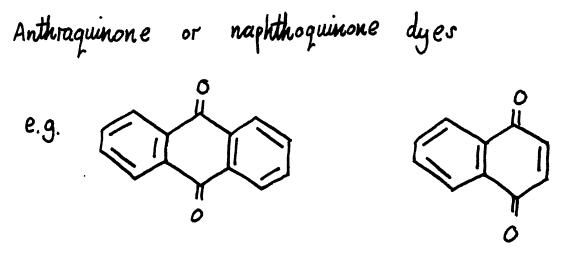CPC Definition - Subclass B41M
This place covers:
- Non-digital and digital printing processes in general, wherein an image or pattern is created on a substrate surface.
- Materials used in such processes.
This place does not cover:
This place covers:
- Non-digital printing methods, i.e. "conventional" printing methods.
- Only methods that are purely printing methods.
This place covers:
Non-digital printing methods, i.e. "conventional" printing methods, used for printing on other surfaces than orfinary paper, including: metals, organic plastics, horn or similar materials, rubber, glass or ceramic surfaces, wooden surfaces, leather or linoleum.
In this place, the following terms or expressions are used with the meaning indicated:
Ordinary paper | sheets made of traditional paper mass |
This place covers:
Digital or non-digital printing processes.
This place does not cover:
Rapid manufacturing and prototyping of 3D objects by additive depositing |
Attention is drawn to the following places, which may be of interest for search:
Scratch cards | |
Postcards; Greeting, menu, business or like cards; Letter cards or letter-sheets with peel-away layer hiding information | |
Designs or pictures characterised by special or unusual light effects |
This place covers:
E.g. printing adhesive patterns, printing silver ink patterns.
This place covers:
Methods of making (printing) the picture to be transferred.
Attention is drawn to the following places, which may be of interest for search:
Processes for applying transfer pictures or the like | |
Processes for decalcomanias; sheet material therefor |
This place covers:
Methods which concern the security printing process.
This place does not cover:
Security documents |
Attention is drawn to the following places, which may be of interest for search:
Preventing copies being made of an original by using an original which is not reproducible or only reproducible with a different appearence | |
Testing paper currency |
This place covers:
E.g. images printed with differently reflecting pigments.
This place covers:
Methods for printing on wallpapers.
Attention is drawn to the following places, which may be of interest for search:
Paperhanging | |
Flexible structures being applied by the user, e.g. wallpaper |
This place covers:
- Printing methods for printing on different kind of surfaces.
- Digital printing, i.e. not using printer's forme.
- Apparatus related methods excluded.
This place covers:
Methods where the ink is used in a special way, e.g. two per se known inks are used in combination giving a special effect.
This place covers:
Methods for printing characterised by the ink receiving properties of the paper without a separate ink receiving layer.
This place covers:
Digital printing methods, i.e. not using printer's forme, used for printing on other surfaces than orfinary paper, including: metals and oxidated metal surfaces, plastics, horn, rubber, other organic polymers, glass, ceramic, tiles, concrete, stones, wooden surfaces, leather, linoleum, skin or flowers.
Attention is drawn to the following places, which may be of interest for search:
Deposition of organic semiconductor materials on a substrate by ink-jet printing |
In the subgroup B41M 5/0041 and in its hierarchical lower subgroups it is highly desirable to add, if applicable, complementary classification in B41M 5/0082 or in its hierarchical lower subgroups.
For example, if the invention is about an ink-jet printing method on a wooden surface, both classes B41M 5/0047 and B41M 5/0076 should be given.
However, if the invention is about an ink-jet printing method on a wooden surface having a particular shape (e.g. curved surface), the following classes should be given: B41M 5/0088 and B41M 5/0076.
In this place, the following terms or expressions are used with the meaning indicated:
Ordinary paper | sheets made of traditional paper mass |
In the subgroup B41M 5/0082 and in its hierarchical lower subgroups it is highly desirable to add, if applicable, complementary classification in B41M 5/0041 or in its hierarchical lower subgroups.
For example, if the invention is about an ink-jet printing method on a wooden surface, both classes B41M 5/0047 and B41M 5/0076 should be given.
However, if the invention is about an ink-jet printing method on a wooden surface having a particular shape (e.g. curved surface), the following classes should be given: B41M 5/0088 and B41M 5/0076.
This place covers:
Transfer printing with intermediate carrier.
The principle of transfer printing is as follows:
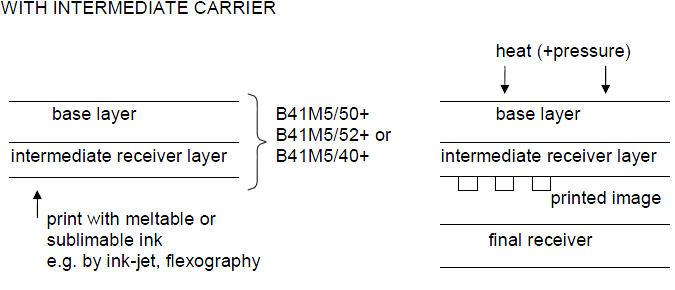
the image transfers by melting: B41M 2205/06
the image transfer by sublimation: B41M 2205/02
B41M 5/025 (melting image)
B41M 5/035 (sublimating image)
B41M 5/0256 (melting + sublimating image)
This place covers:
E.g. transfer pictures for T-shirts are quite often printed with this kind of method.
In this place, the following terms or expressions are used with the meaning indicated:
Computer driven printer | printers for digital printing methods, i.e. methods not using printer's form |
This place covers:
- Methods wherein the already printed design is transferred using heat on a substrate.
- Only the design i.e. the ink is transferred and not the whole layer. The designs may be produced by the methods classified in B41M 5/0256.
This place does not cover:
Methods concerning imagewise heating |
This place covers:
Printing methods where the transfer of the ink from the master sheet is made by sublimation or volatilisation of desing and wherein the method is characterised by specific details of the mechanisms to obtain the transfer, e.g. the heating means, the pressure means or the transport means.
Attention is drawn to the following places, which may be of interest for search:
Transfer printing apparatus |
This place covers:
Pressure sensitive papers.
This place covers:
Methods wherein the material is removed from the surface (only ablation imaging).
Attention is drawn to the following places, which may be of interest for search:
Working by laser beam, e.g. welding, cutting, boring | |
Processes for producing decorative surface effects by removing surface-material with laser radiation |
This place covers:
Methods wherein the material changes colour, when marked (without ablation).
Attention is drawn to the following places, which may be of interest for search:
Laser applications in general |
This place covers:
Thermographic recording or marking methods of inorganic surfaces or materials, including: glass, metal or ceramics. The recording or marking is usually made by an infrared laser.
Attention is drawn to the following places, which may be of interest for search:
Marking glass |
This place covers:
- Also irreversible thermographic methods.
- Characteristic for these methods is that there is no chemical reaction, i.e. the colour change takes place within one compound or by destroying said compound.
This place covers:
- Thermography without transfer, i.e. thermo-sensitive recording, direct thermal recording.
- There is chemical reaction between two or more compounds, which results in colour change.
The following table shows the relevant classification places for different layers of direct thermal recording sheets:
covering or protecting layer | B41M 5/42 and its hierarchical lower subgroups |
imaging layer | |
support | |
backcoat | B41M 5/42 and its hierarchical lower subgroups |
+ B41M 2205/00*
*An Indexing Code (a hierarchical lower subgroup of B41M 2205/00) is given to specify the printing method and layer (e.g. direct thermal printing, intermediate layer, back layer, etc.).
In this place, the following terms or expressions are used with the meaning indicated:
Colour developing components | anything that reacts with the colour formers |
This place covers:
Sulphur compounds having phenolic or carboxylic acid groups.
This place covers:
- Only the donor layers for imagewise heating.
- The donor layers of the thermal transfer ribbons are classified in this subgroup and its hierarchical lower subgroups.
Attention is drawn to the following places, which may be of interest for search:
Deposition of organic semiconductor materials on a substrate using non liquid printing techniques, e.g. thermal transfer printing from a donor sheet |
The following table shows the relevant classification places for different layers of thermal transfer donor sheets:
donor layer | B41M 5/382 and its hierarchical lower subgroups |
intermediate layer | B41M 5/42 and its hierarchical lower subgroups |
substrate | |
backcoat | B41M 5/42 and its hierarchical lower subgroups |
*An Indexing Code (a hierarchical lower subgroup of B41M 2205/00) is given to specify the printing method and layer (e.g. melt transfer, d2t2, intermediate layer, back layer, etc.).
The principles of melt transfer and sublimation transfer are as follows:
melt transfer:
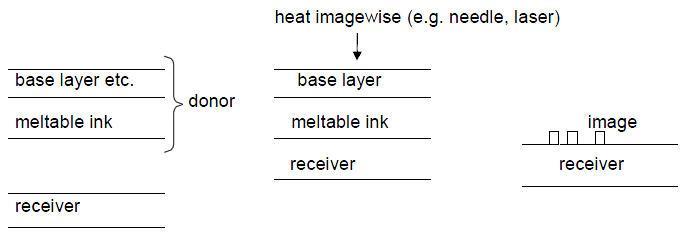
B41M 5/382 and its hierarchical lower subgroups
+ B41M 2205/06 (for melt transfer)
sublimation transfer:
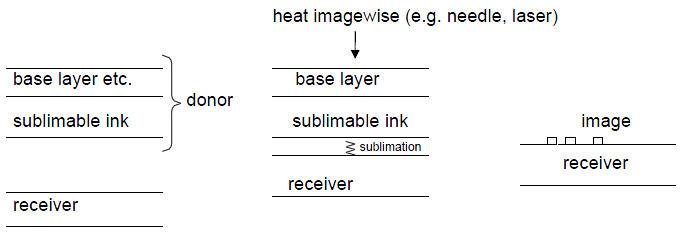
B41M 5/382 and its hierarchical lower subgroups
+ B41M 2205/02 (for sublimation transfer)
This place covers:
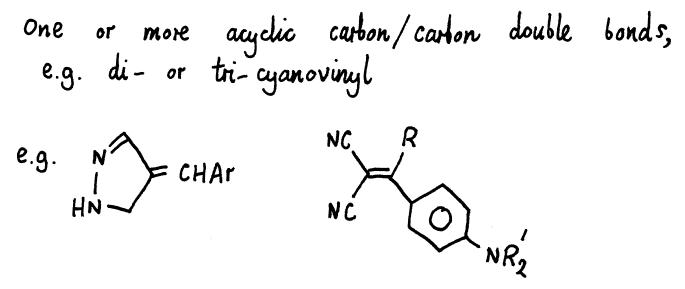
This place covers:
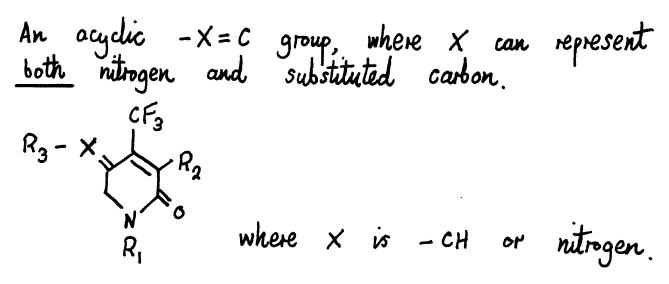
This place covers:
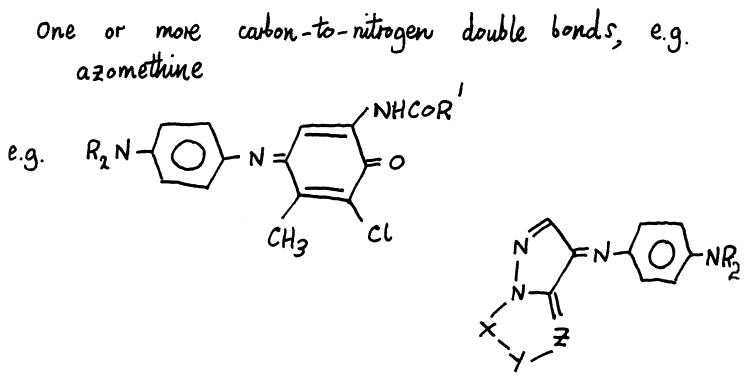
This place covers:
The layer structures of both direct thermal recording and thermal transfer sheets (= thermal transfer donor sheets and thermal transfer receiving sheets) except the image receiving layer of the thermal transfer receiving sheets (see the table below).
Classification for thermal transfer receiving sheets:
image receiving layer | B41M 5/52 and its hierarchical lower subgroups |
intermediate layer | B41M 5/42 and its hierarchical lower subgroups |
Substrate | |
Backcoat | B41M 5/42 and its hierarchical lower subgroups |
*An Indexing Code (a hierarchical lower subgroup of B41M 2205/00) is given to specify the printing method and layer (e.g. direct thermal printing, intermediate layer, back layer, etc.).
An Indexing Code (a hierarchical lower subgroup of B41M 2205/00) shall be used to show which layer is in question, e.g. intermediate layer, cover layer or back layer.
This place covers:
The following table shows the relevant classification places for different layers of all but thermal recording sheets:
ink receiving layer | B41M 5/52 and its hierarchical lower subgroups |
intermediate layer | |
substrate | |
backcoat |
*An Indexing Code (a hierarchical lower subgroup of B41M 2205/00) is given to specify the layer (e.g. intermediate layer, back layer, etc.).
In the following the principle of transfer printing when the whole layer with the printed image is transferred is shown:
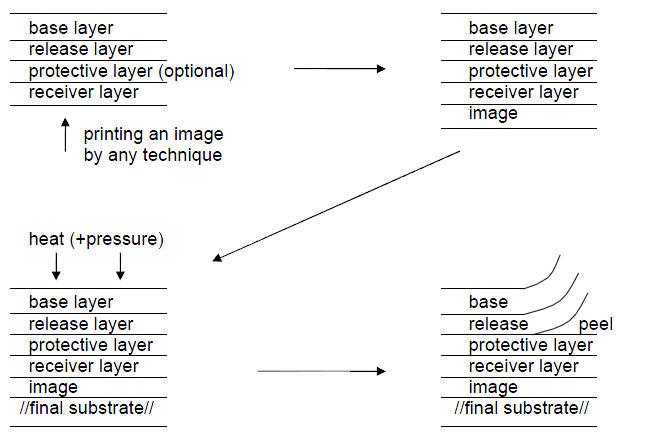
for the method: B41M 2205/10
for the protective layer: B41M 7/0027, B41M 7/0036, B41M 7/0045 or B41M 7/0054
This place covers:
- Intermediate, support, and backcoat layers for non-thermal receiving elements.
- Particular shapes in receiving sheets, e.g. perforations, missing corners.
This place covers:
Ink, dye or pigment receiving coatings/layers for recording sheets.
This place covers:
- Any kind of after-treatment of previously printed material, also protective coatings.
- After-treatment of both digitally and non-digitally (by conventional printing methods) printed products.
Attention is drawn to the following places, which may be of interest for search:
Pre-treatment or treatment during printing |
This place covers:
E.g. methods relating to mechanical removing of the ink.
Attention is drawn to the following places, which may be of interest for search:
Application of ink-fixing material on the substrate prior to printing |
Attention is drawn to the following places, which may be of interest for search:
After-treatment of prints, e.g. heating, irradiating |
